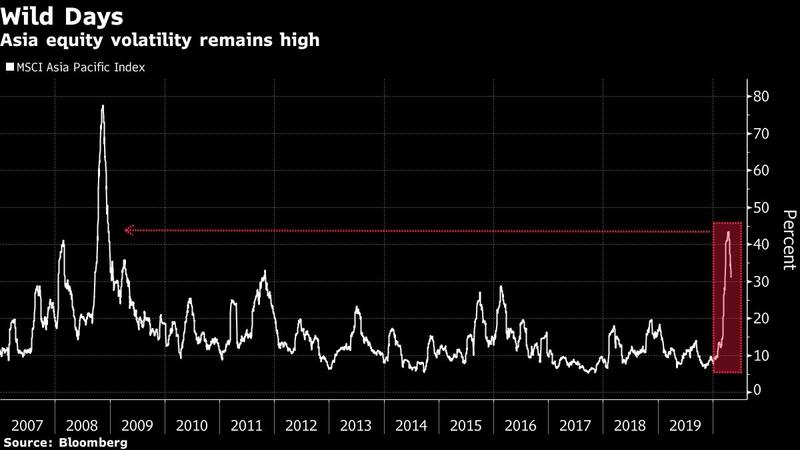
Asia Pacific stocks have finally risen more than 20 percent from their recent lows and are set to join global peers in a bull market.
The MSCI Asia Pacific Index advanced 0.9 percent as of 5:29 pm in Hong Kong, climbing for a third day. This will make it one of the last major regional gauges to enter a bull market, weeks after those in the US, Europe, Southeast Asia and Latin America. Energy shares, the worst performers in the early part of the year, and drugmakers are leading the Asian rebound.
The MSCI Asia Pacific Index tumbled as much as 30% from a January high as the virus spread across the globe, bringing travel and entire economies to a standstill
Asian stocks were the first to face investor fears, with the region housing the epicenter of the coronavirus. Their vulnerability was exacerbated by countries’ open capital accounts, strong trade and tourism links to China, and weakening currencies versus the greenback. Now, after billions of dollars pledged in stimulus measures, investors are dipping their toes back in, while weighing the potential for another wave of infections as Asian nations consider reopening their economies.
READ MORE: Refinitiv: Asian stock valuations drop to 15-mth low in March
The strong fiscal response globally “has enabled Asia markets to recover from their lows where they had already built in a significant risk premium for a permanent solvency shock to corporates,” said Colin Harte, a multi-asset portfolio manager at BNP Paribas Asset Management.
The MSCI Asia Pacific Index tumbled as much as 30 percent from a January high as the virus spread across the globe, bringing travel and entire economies to a standstill. Fast forward a few weeks, and some of the region’s equity markets that witnessed trading halts and even bourse closures became the first to climb out of bear territory, buoyed by bargain hunting and short covering.
South Korea led the way on March 31, followed by the Philippines and Indonesia in early April. Thailand, Australia, New Zealand, Taiwan, India and Vietnam have since joined the club. Despite it being the epicenter of the disease, China’s equity market managed to avoid bear territory, with support from onshore brokerages.
ALSO READ: Some Asian markets surge to bull territory on easing death toll

Too early
Asian governments and central banks have been doing their bit to support companies, doling out billions in stimulus packages and slashing interest rates in emergency cuts. In the latest move, the Bank of Japan scrapped a limitation on buying government bonds and ramped up its purchases of corporate debt. Expectations of volatility, however, remain high as investors fear a steep drop in corporate profits.
That “will prevent a return to normality,” Pascal Blanque, Amundi’s group chief investment officer wrote in a note. “Volatility is expected to remain high, although it won’t be as extreme as when the crisis first hit as many quant-driven portfolio adjustments have already taken place.”
ALSO READ: Stocks rise in Asia with US futures; dollar dips
The regional gauge remains down 14 percent for the year as investors tune in to the ongoing corporate earnings season for updates on company outlooks. Companies from Beijing to Sydney have been forced to abandon guidance, furlough workers and reduce spending to deal with lockdowns. Fidelity International analysts are bracing for a full-year earnings cut of 44 percent on average across firms globally.
“It is unlikely that equity indices will return to their recent highs for some time,” BNP Paribas Asset Management’s Harte said.



